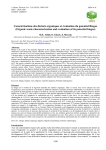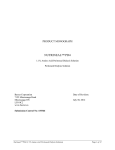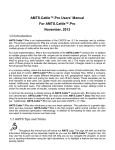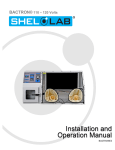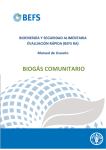Download - rtd
Transcript
Project no. 513949 Project acronym: EU-AGRO-BIOGAS Project title: European Biogas Initiative to improve the yield of agricultural biogas plants Instrument: Specific targeted research or innovation project Thematic Priority: Priority 6, Sustainable Energy Systems Deliverable 18: User manual for the automatic monitoring, management and early-warning system Due date of deliverable:2009-11-30 Actual submission date: 2009-12-12 Start date of project: 2007-01-15 months (2007-2009) Duration: 36 Organisation name of lead contractor for this deliverable: Partner N° 2, North Wyke Research, (Rothamsted Research) 1 Deliverable 18: User manual for the automatic monitoring, management and early-warning system Abstract The rationale for monitoring biogas production is that biogas plants that operate without online monitoring may be underperforming. Furthermore, for economic reasons more plants are operating in a critical (load) range where there is a risk of a digester failure that results in financial deficits. In the case of larger plants, the cost of online monitoring is only a small fraction of the total costs. Controlling the biogas production process can be difficult, often because different feedstocks are used that have different process requirements and / or produce different responses with the measuring equipment. Therefore the intention of this manual is to determine those generic process control parameters that can be considered for all biogas plants. The need to prevent digester failure or acidification is a real possibility as we approach an optimum biogas output. Identification of key parameters for process monitoring is the first stage to prevent methanogenesis failure. Second, automatic monitoring will also help to develop the most appropriate process control approaches using these key parameters and prevent the real possibility of plant breakdown and aid process diagnosis. Third automatic monitoring will help to identify the dynamics of change and give early warning of several important changes. Here we provide a manual for a softsensor approach, the use of near infrared reflectance spectroscopy, an electronic nose and volatile fatty acid analysis 2 Contents 1. Document Description 2. Introduction 2.1 Soft sensors 2. 2 Sensors 2.3 Near Infrared Reflectance Spectroscopy 2.4 Electronic Nose 3. Important biogas plant fermentation parameters to monitor. 3.1 pH 3.2 Alkalinity 3.3 Electrode sensors real time alkalinity determination 3.4 Volatile fatty acids (VFAs) 3.5 On-line measurement of volatile fatty acids (VFA) 3.6 Redox potential 4. General indicator trends in biogas production 5. Hardware and software 5.1 Computer 6. Softsensor early warning system 6.1 Software 6.2 Development of softsensor to measure alkalinity 6.3 Storage of data 7. Portable Electronic Nose 7.1 Hardware-Configuration 8. Near Infrared reflectance spectroscopy 8.1 Determination of VFA in the digester by NIRS 9. Further Reading/Information 10. References 3 List of tables and Figures Table 1: Hardware and software components. Table 2. Statistical data summary as an example for different models to assess the analysis of acetic and propanoic acids by NIRS. RMSEV root mean square error of validation (average error, lower is better) RPD residual prediction deviation (ratio of RMSEV to standard deviation, greater than three is a good model) Figure 1. LabVIEW™ vi front panel showing the controls tab where you set various parameters such as OLR, total solids & volatile solids content, feed loop time, tank mixing times and frequency of mixing. Figure 2. Flow diagram showing hardware and software steps required to calculate the predicted alkalinity, next organic loading rate, and digestate transfer pump operation times. Figure 3. Part of the Block Diagram code explaining how the OLR is calculated based on the current and previous predicted alkalinity. This algorithm considers the difference in magnitude between the current and previous alkalinity, together with comparing the current predicted alkalinity with the set points, and the previous OLR. Figure 4. Measuring-adapter with specimen holder Figure 5. fixed outer guide tube Figure 6. On-line fitting of reflectance probe to a digester. Figure 7. On-line fitting of reflectance probe to 30 cubic metre cattle manure digester outlet. 4 1. Document Description This user manual was produced as a requirement of Task 6.2 of work package 6 in the EU-AGRO-BIOGAS project entitled European Biogas Initiative to improve the yield of agricultural biogas plants Proposal/Contract no.:019884. Task 6.2 is defined as “Demonstration of automatic monitoring, management and early-warning system” (Months 8-15) This deliverable provides information by developing reliable automatic monitoring, management and early-warning system in the form of user manual. All project partners except for Partner 14 (RTDs) were involved as shown in Table 1. Table 1 Project partners Participant 1 id: Person-month per participant 0.5 2 3 4 5 6 7 8 9 10 11 12 13 10.0 0. 5 3.0 5.0 0.5 0.5 0.5 0.5 0.5 0.5 0.5 0.5 5 2. Introduction A description of the different means of monitoring are described in this section. This includes soft-sensors, near infrared reflectance spectroscopy (NIRS), and an electronic nose. These were previously identified as the best means of automatic monitoring of biogas plants in real time so that adaptive process control could be used to avert fermentation failure and optimum biogas production. 2.1 Soft sensors: Soft sensor or virtual sensor is a common name for the adaptation of several measurements that are processed together to give a prediction of a more relevant parameter. There may be dozens or even hundreds of measurements. The interaction of the signals can be used for calculating new quantities that are otherwise difficult to measure. Soft sensors are especially useful in data fusion, where measurements of different characteristics and dynamics are combined. It can be used for fault diagnosis as well as control applications. To implement soft sensors for use in process control often requires the use of neural networks or fuzzy computing. 2.2 Sensors: For this manual were are concerned with electrode sensors that measure pH, Redox, conductivity and temperature. These were supplied by Partech instruments (St Austell Cornwall UK) supplied the above electrodes to monitor pH, redox, conductivity and temperature for the soft-sensor development. Data from the probes can be downloaded into a file via instrument operating software such as LabView™. 2.3 Near Infrared Reflectance Spectroscopy The IR region of the electromagnetic spectrum runs from < 400 cm-1 to 14285 cm-1 and can be split into three parts: far IR, mid IR, and near IR. The near infra-red region of the electromagnetic spectrum spans from 14285 – 4000 cm-1. Infra-red spectroscopy is a powerful tool for studying a number of applications regarding biological systems. NIRS does not suffer unduly from water band adsorption like mid range IR and is also fast, in that data is delivered within 1-2 minutes, often sample pretreatment is not required and it is non-destructive and may allow the simultaneous analysis of several components in complex matrices. NIRS can observe any sample in virtually any state: liquids, solutions, pastes, powders, films, fibres, gases, and surfaces can all be examined to study biological systems such as proteins, peptides, lipids, biomembranes, carbohydrates, pharmaceuticals, foods, and both plant and animal tissues. Parameters such as alkalinity, total and ammonical nitrogen, dry and organic matter and total and individual VFA concentrations can be determined. The magnitude of some of these parameters could be inputs to a control program to determine optimal digester OLRs or be used as a source of advice for biogas plant managers. NIRS has been used to monitor VFAs (Fabian et al 2009), COD, total organic carbon (TOC), and partial and total alkalinity on-line in the liquid phase. 2.4 Electronic Nose An electronic nose is a device intended to detect volatile compounds and is associated with odour emissions from foods, pharmaceuticals and other sources. Over the last decade, “electronic sensing” or “e-sensing” 6 technologies have undergone important developments from a technical and commercial point of view. The expression “electronic sensing” refers to the capability of reproducing human senses using sensor arrays and pattern recognition systems. The stages of the recognition process are similar to human olfaction and are performed for identification, comparison, quantification and other applications. These devices have undergone much development and are now used to fulfil industrial needs. Electronic Noses include three major parts: a sample delivery system, a detection system, a computing system. The sample delivery system enables the generation of the headspace (volatile compounds) of a sample, which is the fraction analyzed. The detection system, which consists of a sensor set, is the “reactive” part of the instrument. When in contact with volatile compounds, the sensors react, which means they experience a change of electrical properties. Each sensor is sensitive to all volatile molecules but each in their specific way. Most electronic noses use sensor arrays that react to volatile compounds on contact: the adsorption of volatile compounds on the sensor surface causes a physical change of the sensor. The computing system works to combine the responses of all of the sensors, which represents the input for the data treatment. 3. Important biogas plant fermentation parameters to monitor. Parameters can be monitored using ‘hard’ sensors like: pH, redox potential, conductivity, and temperature sensors. The alkalinity value is predicted (‘soft’ sensor) using an algorithm based on the magnitude of the conductivity, pH, and redox potential measurements. In addition, near infra-red spectroscopy (NIRS) probes installation allows other parameters such as volatile fatty acids or alkalinity to be measured on line using a predetermined calibration model. Details on installing different probes can be found in supplier’s user manuals. 3.1 pH For the hydrolysis stage an acidic pH (5 to 6.5) encourages hydrolysis (autohydrolysis) and is therefore important. There are robust sensors that are used to monitor the hydrolysis stage. Generally a low pH is indicative of effective hydrolysis. Conductivity also can measure the degree to which natural polymers have been broken into their smaller parts. Analysis of the volatile fatty acids from the hydrolysis stage can be made offline with a liquid chromatography system. There are off-line sampling devices that can provide such a sample. The ratio and concentrations of the volatile fatty acids consisting of acetic, propionic, butyric and iso-butyric acids are important process monitoring parameters The methanogenesis stage is neutral pH during good operation. The same sensors and electrodes used to monitor this stage as the hydrolysis stage. The primary conditions for good biogas production involve providing the best environment for the Archaea that produce methane. These conditions include a pH 6.8 to 8, access to volatile fatty acids and not too rigorous stirring. The redox potential should be more negative than -250mV. 7 The ideal pH range for methanogenesis is very narrow: pH 6.8-7.2. 3.2 Alkalinity Buffer capacity is often referred to as alkalinity (mq CO3.-1l) in the methanogenesis stage, which is mostly an equilibrium of carbon dioxide and bicarbonate ions that provides resistance to significant and rapid changes in pH. Buffer alkalinity is a more reliable method of measuring digester imbalance than pH. An accumulation of short chain fatty acids will reduce the buffering capacity significantly before the pH decreases. Several monitoring systems have been investigated. Automatic flow titrator for monitoring alkalinity, rule based algorithms will help to measure estimated alkalinity from the measurements using other sensors. 3.3 Electrode sensors real time alkalinity determination Monitoring was primarily in the liquid phase by pH, redox and conductivity probes mounted in each of the two vessels (pilot plant Tank 1 and tank 2), the data from these sensors was used as inputs to an algorithm or software sensor for prediction of the bicarbonate alkalinity. All actuators were controlled via software, with the organic loading rate modulated by rules based process control approach. Alkalinity was predicted using the same algorithm but with different factors as in Eqn1 and Eqn2. The factors for the equations were determined using multiple linear regression of the real alkalinity as determined by autotitration and the pH, Redox and conductivity values as measured by the sensors. Algorithm 1: predicted alk = -8906 + (1678 x pH) + (1.998 x redox) + (384.2 x EC) Algorithm 2: predicted alk = 4876 + (22 x pH) + (0.16 x redox) + (-223 x EC) Nb redox potential in mV and EC in mS 3.4 Volatile fatty acids (VFAs) Volatile fatty acids (VFAs) have long been recognised as the most important intermediates in the biogas production process and have been proposed as a control parameter. AD processes are sensitive to hydraulic or organic overloading due to imbalanced or insufficiently controlled feeding. The relative concentrations of the volatile fatty acids; consisting of acetic, propionic, butyric and iso-butyric acids are important process monitoring parameters. The ratio between propionic acid and acetic acid can be determined using an offline instrument and can be used to identify effective methanogenesis. Different approaches were developed for on-line monitoring of VFAs (J von Sachs et al, 2003; Feitkenhauer et al 2002, Pind et al 2003, Boe et al 2005). These on-line approaches include spectrophotometer methods and titration methods respectively. A new online method for VFAs in digester samples has been developed through gas phase extraction, i.e. online headspace 8 chromatographic method for measuring VFA in biogas reactor (Boe et al, 2005). This method needs no sample filtration, which is of advantage for samples with high solids. Nielsen et al, (2007) demonstrated an online VFA sensor in order to study VFA dynamics during stable and unstable operation of the biogas plant. They identified propionate concentration as a key parameter for optimizing the biogas process. By on-line monitoring of VFAs, loading rate (feed) in to the anaerobic digester can be controlled. 3.5 On-line measurement of volatile fatty acids (VFA) There are a range of methods for the online measurement of VFA in anaerobic digesters, this one was developed based on headspace gas chromatography (HSGC). The method applies ex situ VFA stripping with variable headspace volume and gas analysis by gas chromatography-flame ionization detection (GC-FID). In each extraction, a digester sample was acidified with H3PO4 and NaHSO4, and then heated to strip the VFA into the gas phase. The gas was sampled in a low friction glass syringe before injected into the GC for measurement. The system has been tested for online monitoring of a lab-scale CSTR reactor treating manure for more than 6 months and has shown good agreement with off-line analysis. The system is capable of measuring individual VFA components. This is of advantage since specific VFA components such as propionic and butyric acid can give extra information about the process status. Another important advantage of this sensor is that there is no filtration, which makes possible application in high solids environments. The system can thus be easily applied in a full-scale biogas reactor by connecting the system to the liquid circulation loop to obtain fresh sample from the reactor. Local calibration is needed but is automatic. Calibration is also possible using a standard addition method. Sampling duration is 25–40 min, depending on the washing duration, and sensor response is 10 min. This is appropriate for full-scale reactors, since dynamics and feeding intervals of most biogas reactors are of the order of several hours. For further information please read Boe et al (2007). 3.6 Redox potential Strictly anaerobic bacteria such as methanogens need a strongly reducing environment with redox potentials below -330 mV to perform well. If the feedstock inputs are stable then redox potential enables detection of disruptions to the process even earlier than the VFA/TIC ratio. A difference of 10mV in -500mV can indicate that changes are about to occur. The redox potential change can identify problems earlier than the VFA/TIC ratio. In addition the redox sensor is more stable that the pH sensor. During the biogas fermentation process the hydrogen gas concentration can change. Generally for energy crops the hydrogen concentration is less than 200 ppm v/v and for organic wastes less than 500ppm v/v. In experiments at North Wyke the hydrogen gas would suddenly fall and then increase before digester failure. So a trend could be identified and integrated into the process control software. Gas phase H2 concentration has previously been measured in anaerobic digesters to determine the effectiveness of this parameter for process state determination (Guwy et al. 1997; Mathiot et al. 1992). It has been shown that the partial pressure of H2 is an important disturbance indicator, in those changes in both the quantity and composition of the substrate produces rapid peaks in H2 partial pressure (Guwy et al. 1997) but 9 this did not necessarily mean process failure. In addition, the absolute concentration of biogas hydrogen was not constant following similar process overload situations (Guwy et al. 1997). 4. General indicator trends in biogas production During a stable fermentation of biogas production the pH, alkalinity, conductivity and methane concentration either remain stable or increase with time. During a period of instability these may decline. Such parameters could be used in several different process control approaches to maintain a stable fermentation process. Important biogas plant fermentation parameters with functional range pH hydrolysis: 4.0 – 6.5 pH methanogenesis: 6.8 -7.4 Redox potential -330 and lower Alkalinity or buffering capacity: over 4000 mg.l-1 bicarbonate Mesophilic temperatures 37 to 39oC VFA/TIC ratio < 0.3 Thermophilic temperatures 50 to 55oC HRT energy crops 60 – 120 days HRT manure & food wastes 10 to 25 days 5. Hardware and software Below are the examples of different hardware and software components for automatic monitoring Components WaterWatch 2620 Multi parameter Monitor Dip Probe/Sonde Configuration pH, Redox, Conductivity, Temperature probes Details The WaterWatch2620 system provides a compact, cost effective package for monitoring a suite of standard parameters in either discrete dip probe or combined sonde configuration. use This system can measure up to seven parameters Including, pH, Redox, Conductivity, Temperature, DO,SS and Turbidity. Source www.partech.co.uk pH sensor -199660 Redox electrode201300 Conductivity Sensor220501 BNC plug in type www.partech.co.uk 10 RS232 NI PCI-232/16 (RS232) Temperature220500 Legacy 16-port RS232 interface for Windows Me/9x/NT, LabVIEW Real-Time Data acquisition and control www.ni.cim www.ni.cim SCSI-100 connector; converter cable and breakout box (SCSI-100 to 16port DE9M [DB9]) Standard baud rates up to 115.2 kb/s (1 Mb/s with NI PCI8430/16) Computers Windows 98, Me, 2000 and XP compatible. The computer you use for your DAQ system can drastically affect the maximum speeds at which you can continuously acquire data. Please make sure that the computer on which you plan to install Lab VIEW or any other software to control plant and for data acquisition that meets the minimum system requirements for the program to run. The data transfer capabilities of your computer can significantly affect the performance of your DAQ system. The limiting factor for acquiring large amounts of data often is the hard drive. Disk access time and hard drive. LabVIEW 8.2 graphical programming Near Infra-Red Spectrometer Bruker Matrix-F FTNIRS with optic cable ABB Bomen / QInterline QFA Flex with diffuse reflectance probe headspace gas chromatography (HSGC) Use full development of test, measurement, and control applications Reflector-NIR-12S300/051220/1 QIA 2050 Computer Disk VFAs Hard 64 B transmit and receive FIFOs (128 B with PCI-8340/16) www.ni.cim www.brukeroptics.com www.q-interline.com gas chromatographyflame ionization detection (GC-FID) Biotechnol. Bioeng. 2007;96; 712–721 Table 1: Hardware and software components. 5.1 Computer: The computer you use for your DAQ system can drastically affect the maximum speeds at which you can continuously acquire data. For remote DAQ applications that use RS-232 or RS-485 serial communication, 11 Your data throughput is usually limited by the serial communication rates. When choosing a DAQ device and bus architecture, keep in mind the data transfer methods supported by your chosen device and bus. Fragmentation can significantly reduce the maximum rate at which data can be acquired and streamed to disk. For systems that must acquire high-frequency signals, select a high-speed hard drive for your PC and ensure that there is enough contiguous (unfragmented) free disk space to hold the data. In addition, dedicate a hard drive to the acquisition and run the operating system (OS) on a separate disk when streaming data to disk. Applications requiring real-time processing of high-frequency signals need a high-speed, 32-bit processor with its accompanying coprocessor or a dedicated plug-in processor such as a digital signal processing (DSP) board. If the application only acquires and scales a reading once or twice a second, however, a low-end PC can be satisfactory. 6 Softsensor early warning system 6.1 Software There is a selection of instrument control software available. Here we describe just one, LabVIEW™ to highlight necessary features and requirements. We configured the LabVIEW™ software includes a graphical interface and a data acquisition system, simple level sensor calibration procedure, real time displays of measurements and results, facilities for remote diagnostics, plus backup and restore of mainstream configuration. The LabVIEW™ software, was used to control feedstock and digestate pumping and mixing events and also acquires, displays, and saves real time data from the probes installed in the tanks. ‘Soft’ sensors can also be developed allowing LabVIEW™ to predict the value of parameters such as alkalinity (HCO3-) from measuring parameters such as pH, redox potential, and conductivity. Automatic process control decisions, such as the organic loading rate, can then be made by LabVIEW™ depending on the magnitude of these parameter values. 12 Figure 1. LabVIEW™ vi front panel showing the controls tab where you set various parameters such as OLR, total solids & volatile solids content, feed loop time, tank mixing times and frequency of mixing. 13 Figure 2. Flow diagram showing hardware and software steps required to calculate the predicted alkalinity, next organic loading rate, and digestate transfer pump operation times. Note the sensors that are used include redox, pH, conductivity and temperature probes. These are interfaced to the RS232 via the Waterwatch series from Partech Ltd., that converts the four signals into RS232 compatible mode 14 Previous predicted alkalinity Current predicted alkalinity Current predicted alkalinity – previous predicted alkalinity from previous loop iteration Different settable alkalinity ranges set on the Front Panel: Rule Based control tab in Fig. 5. Previous OLR + increment or decrement depending on where the current predicted alkalinity falls in the settable ranges. 15 Takes the Previous OLR + increment or decrement, then adds the result from the derivative calculation to give the new OLR for the next feed event Figure 3. Part of the Block Diagram code explaining how the OLR is calculated based on the current and previous predicted alkalinity. This algorithm considers the difference in magnitude between the current and previous alkalinity, together with comparing the current predicted alkalinity with the set points, and the previous OLR. 6.2 Development of softsensor to measure alkalinity To develop the softsensor to measure alkalinity requires that we collate the data from the sensors and perform a multi-linear regression analysis against the alkalinity as measured in the laboratory. Alkalinity can be determined by titration against a acid solution, normally a dilution of sulphuric acid. Also there are a range of auto-titrators available that titrate acid to the digestate, as well as a manual titration procedure to determine the alkalinity. Most statistical packages will perform a multi-linear regression here we used a Genstat™ statistical package. The software identifies the most relevant factors and weightings to provide an equation to determine the alkalinity. It is important not to over model the alkalinity in the softsensor as erroneous predictions can result. 6.3 Storage of data The LabVIEW™ vi can be used for data acquisition. Data from sensors like temperature, pH, redox potential, conductivity and other data like biogas volume tally, and hourly rate of biogas production can be acquired and stored. The operation of this method of early warning system proved effective for cattle slurry and a mixture of cattle slurry and grass silage for a pilot plant system. This system of process control was not validated for a larger commercial scale biogas plant. 7 Portable Electronic Nose 7.1 Hardware-Configuration In this instance the Portable Electronic Nose (PEN) can be used for the quantitative identification of propionic acid in biogas. A high level of standardisation is needed to get comparable results from PENmeasurements, which includes the configuration of the used hardware. Therefore a specimen holder as well as a stamp-formed tube- and cannulacarrier was developed. For the measurements, it was furthermore determined to purge the needed fresh-air by an activated charcoal filter and the delivery rate of the pump was fixed at 250 ml/min during measurement. 16 Figure 4. Measuring-adapter with specimen holder An easy to operate stamp-device was built from a mobile inner acrylic glass tube and a fixed outer guide tube (see figure 4). At the bottom of this device, a silicon-made plug was fixed with two cannulas for the supply- and exhaust-air. These were diametrically opposed with a distance of 10 mm from the centre and a penetration depth of 15 mm (see figure 5). To attach the stamp-device on the septum of the measuring tube, the device handle is pulled down with one hand and, while removing, the measuring tube is fixed with the other hand. Between two measurements and for zero point calibration a blank sample is used. Figure 5. fixed outer guide tube The determination of the concentration of acetic and propanoic acids in the headspace can be determined. However there are two further variables to 17 consider before we can determine the impact on the fermentation process these are; 1/. The relationship of headspace concentration to that in the digestate 2/. The levels at which the concentration of these two VFAs act as indicators for process control to be changed. The latter two points highlight the need for further research for the PEN device to be effective for process control. 8 Near Infrared reflectance spectroscopy 8.1 Determination of VFA in the digester by NIRS Before we can determine the acetic or propanoic acid concentration in the digester we need to calibrate the NIRS system with known concentrations of acetic and propanoic acids in the digester liquid. Here we describe the method to calibrate a NIRS system to monitor VFAs in a digester. One litre samples were collected five times a week for a five month period and VFA species were measured by gas chromatography for NIRS calibration. The samples were prepared for NIRS analysis by heating them to the reactor temperature in one litre beakers. The beakers were then placed on rotary shakers at approximately 100 rpm with the probe fixed above and immersed to a depth of 20 mm. NIRS spectra were acquired with a Bomen QFA Flex Fourier Transform spectrometer, with an optical fibre interface and diffuse reflectance probe. Spectra were collected using Q-Interline INFRAquant software. Each measurement was an average of 256 scans. The advantage of this arrangement was twofold in that the motion caused the sample to be mixed slightly to reduce sedimentation and also that the sample was moved in relation to the probe tip over an elliptical path of approximately 40 mm by 20 mm, thus providing a more representative measurement. Calibration models were constructed with PLSplus/IQ software. The software determines the most relevant areas of the spectra and performs spectral correction and a range of regression options before determining the calibration curve. 18 Figure 6. On-line fitting of reflectance probe to a digester. Figure 7. On-line fitting of reflectance probe to 30 cubic metre cattle manure digester outlet. Table 2. Statistical data summary, as an example, for different models to assess the analysis of acetic and propanoic acids by NIRS. RMSEV root mean square error of validation (average error, lower is better) RPD residual prediction deviation (ratio of RMSEV to standard deviation, greater than three is a good model) 19 Experiment Exp 1 (Pig slurry / silage) Exp 2 (Chicken manure) Exp 3 (Cattle manure) R2 Acetic acid RMS S.D. EV RPD R2 Propanoic acid RMS S.D. EV RPD 0.879 309 1165 3.77 0.919 129 710 5.50 0.817 555 1350 2.43 0.971 135 788 5.84 0.234 312 345 1.11 0.659 110 264 2.40 Exp 1, 2, 3 0.768 722 1479 2.05 0.919 218 912 4.18 Exp 1, 2 0.743 742 1401 1.89 0.952 169 808 4.78 Different methods of presenting the material to the NIRS probe had little effect on model quality, therefore an on-line NIRS system can be as effective as a more labour intensive at-line NIRS analysis. A single model for estimating propanoic acid in different manures can be made by combining the data from all those manures. However, samples from all combinations of manure and / or waste types with a wide range of VFA values are necessary for calibration of a true generic model. Collecting this many samples would be an immense task. NIRS is suitable as a rapid and low maintenance method of determining VFA in digesters with a single unchanging feedstock but is not suitable for biogas plants with a changing input. At North Wyke, we monitor biogas fermentation in a pilot plant using NIRS. The FT-NIRS instrument from Bruker, was configured with a fibre optic (Reflector-NIR-12S-300/051220/1) probe to monitor inside the digester. Near infrared spectroscopy (NIR) was used for real time monitoring of different parameters using the Bruker Matrix-F FT-NIRS with optic cable Near InfraRed Spectrometer - Bruker Optics Limited, Banner Lane, Coventry. CV4 9GH. Tel: 02476 855200. www.brukeroptics.com. This technique is a promising online monitoring technique, and calibration of the NIRS was possible with data from the HPLC analysis for VFAs. This approach was integrated into a pilot scale plant for on-line monitoring of VFAs and other parameters simultaneously to develop an early-warning system. Alkalinity proved to be a good parameter for process monitoring and also to control the feed that influences VFA formation. 20 9. Further Reading/Information Alastair Ward PhD Thesis: Optimisation of biogas production by advanced process monitoring and the effect of mixing frequency on biogas reactors with and without microbial support media Gonzalo Ruiz Filippi, Advanced monitoring and control of anaerobic reactor Department of Chemical Engineering. Universidade de Santiago de Compostela, Spain. (Defended on March 3rd, 2005) Electronic version in pdf can be obtained by sending an e-mail to: [email protected] (note that the document was written in Spanish). Modelling and monitoring the anaerobic digestion process in view of optimisation and smooth operation of WWTPs Usama El-sayed Zaher, BIOMATH, Ghent University, Belgium (defended 14 June 2005) Download: http://biomath.ugent.be/publications/download/zaherusama_phd.pdf IWA Specialist Group on Instrumentation, Control and Automation: 21 10. References: Boe, K., Batstone, D.J. and Angelidaki, I. 2007. An innovative online VFA monitoring system for the anerobic process, based on headspace gas chromatography. Biotechnol. Bioeng. 96; 712–721. Boe, K., Batstone, D.J and Angelidaki, I. 2005. Online headspace chromatographic method for measuring VFA in biogas reactor. Water Science and Technology, 52; 473-478. Fabian Jacobi, H., Moschner, C.R. and Hartung, E. 2009. Use of near infrared spectroscopy in monitoring of volatile fatty acids in anaerobic digestion. Water Science and Technology 60; 339-346 Feitkenhauer, H.,von Sachs, J., Meyer, U. 2002. On-line titration of volatile fatty acids for the process control of anaerobic digestion plants. Water Research 36; 212-218. Guwy, A.J., Hawkes, F.R., Hawkes, D.L., Rozzi, A.G. 1997. Hydrogen production in a high rate fluidized bed anaerobic digester. Water Research 31, 6; 1291-1298. Holm-Nielsen, J. B., Dahl, C. K., Esbensen, K. H. 2006. Representative sampling for process analytical characterization of heterogeneous bioslurry systems – a reference study of issues in PAT. Chemometrics and Intelligent Laboratory Systems, 83; 114126. J von Sachs, Meyer, U., Rys, P., Feitkenhauer, H. 2003. New approach to control the methanogenic reactor of a two-phase anaerobic digestion system. Water Research. 37; 973-982. Nielsen, H.B., Uellendahl, H., and Ahring, B.K. 2007. Regulation and optimization of the biogas process: Propionate as a key parameter. Biomass and Bioenergy. 31; 820-830. Pind, P.F., Angelidaki, I. and Ahring, B.K. 2003. Dynamics of the anaerobic process: effects of volatile fatty acids. Biotechnol Bioeng 82; 791-801. Mathiot, S., Escoffier, Y., Ehlinger, F., Couderc, J.P., Leyris, J.P., Moletta, R., 1992. Control parameter variations in an anaerobic fluidized-bed reactor subjected to organic shock loads. Water Science and Technology, 25, 93-101. Zhang, Y., Zhang, Z., Sugiura, N., and Maekawa, T. 2002. Monitoring of methanogen density using near-infrared spectroscopy. Biomass and Bioenergy. 22; 489-495. 22























